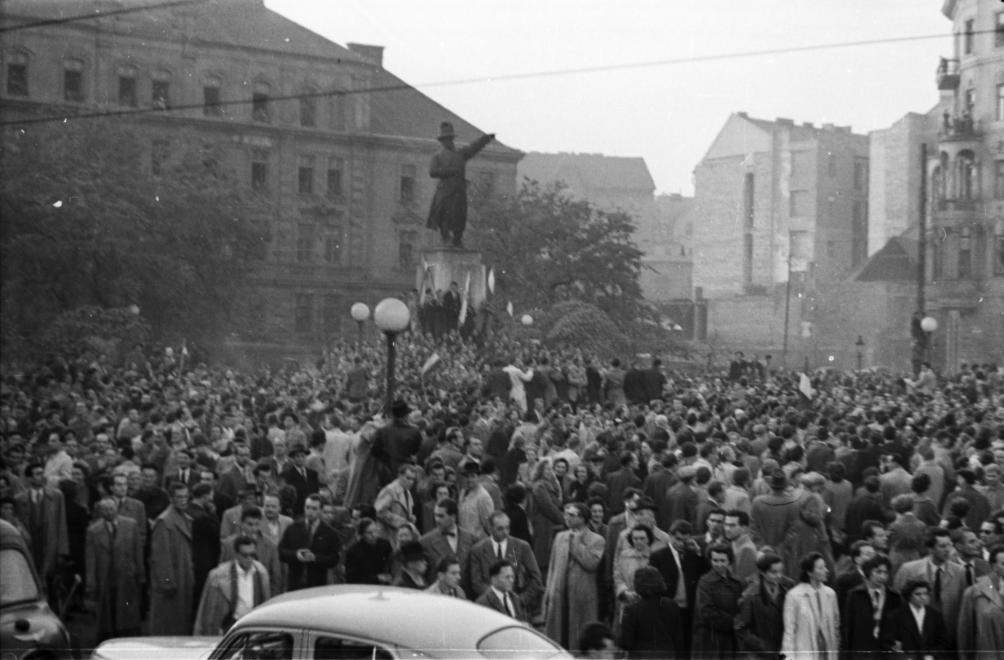The Suez Crisis and the Hungarian Revolution of 1956 – photos, videos

Both happened in October and November of the same year. In the former, the influence of Great-Britain and France on global issues weakened significantly while Egyptian President Gamal Abdel Nasser strengthened his positions. In the latter, the Soviet Red Army restored the communist rule in Hungary by killing thousands of young Hungarian freedom fighters and making hundreds of thousands flee their homeland. But what is the link between them?
Egypt to become the leader of the Arab World
In late October and early November of 1956, all the front pages of the important newspapers were covered with two country names: Egypt and Hungary. From a global point of view, Hungary was the less interesting: after defeated and devastated in WWII, it became a Soviet satellite state with almost no freedom. In contrast, Egypt lead by the ambitious President Gamal Abdel Nasser was competing for the leadership of the Arab World. In fact, Nasser seized control over the country in 1952 after a successful military coup.
Short after that, Nasser began to
balance between the communist and capitalist great powers.
For example, in 1955, he signed an arms deal with Czechoslovakia (which meant the Soviet Union). Furthermore, he strongly supported the Algeria rebellion against France while he expected American money for his Aswan Dam project. His most important aim was to become the leader of the Arab World and consequently, one of the leaders of the non-aligned countries. Meanwhile, Great-Britain (and France) tried to maintain its positions in Egypt and principally near the Suez-canal through which 2/3rd of the oil used in Europe was shipped to the Old Continent.
Nothing but promises
In Hungary, important changes happened after Stalin’s death in 1953. To cut a long story short, Mátyás Rákosi, the hated leader of the Hungarian communists was dismissed and his successor,
Imre Nagy installed reforms
regarding the devastated economy and oppressed public life. However, after a change in Moscow, Rákosi’s circle gained power again, but the Hungarian society strongly resisted and made him resign in July 1956.

Consequently, students, journalists and writers became more active and critical in politics. The situation escalated and on October 23 transformed to revolution. The freedom fighters – most of them under 30 – wanted
to establish a country free from the Soviet Union and following its own interests.
Of course, they immediately asked for help from the United States and the European great powers; however, they received nothing but beautiful promises.
Yalta rules
Just months before in Egypt, Nasser declared the nationalization of the Suez Canal which, of course, seriously harmed British interests in the region.
Thus – after secret agreements – Israel, Great-Britain and France invaded Egypt. The former occupied the Sinai Peninsula while the two latter the Suez Canal between October 29 and November 5.
The United States was afraid of Egypt falling into the hands of the Soviets thus; it tried to end the military conflict as soon as possible. Doing so President Eisenhower declared that he does not regard the new Hungarian political leadership as a potential ally to the United States and
he does not want to give military support for Hungary.
This meant that the United States will not break the Yalta agreement in which Hungary was declared to be a Soviet sphere of interest. Of course, Great-Britain and France concentrated on their wars in the Middle-Eastern region. Hence, even though Radio Free Europe broadcasted day and night that the American help is on its way, the Soviet leader Nikita Khrushchev could easily organize the invasion of Hungary which started on November 4.

On the other side of the world Egypt was militarily defeated, but politically Nasser was victorious while Great-Britain and France suffered a terrible defeat regarding their reputation because of their aggression and secret diplomacy. Meanwhile, Hungary was occupied again by Soviet forces which resulted in the
fleeing of approximately 200,000 people.
For example, Ferenc Puskás, member of the Golden Team of Hungary remained abroad while his four-year-old daughter and his wife managed to escape only in December after many unsuccessful attempts.
Photos: fortepan.hu, facebook.com/pg/magyarforradalom1956
Source:





